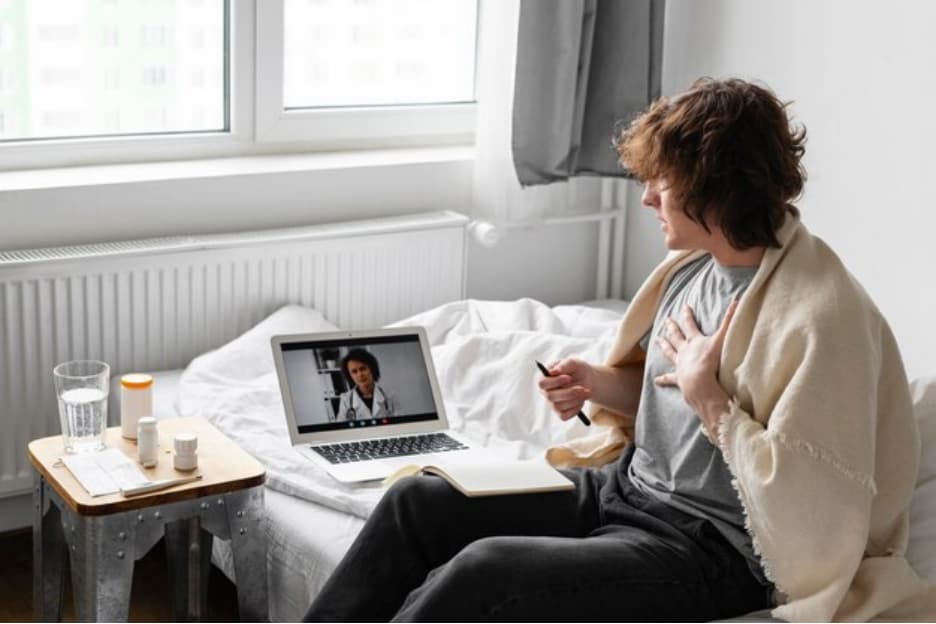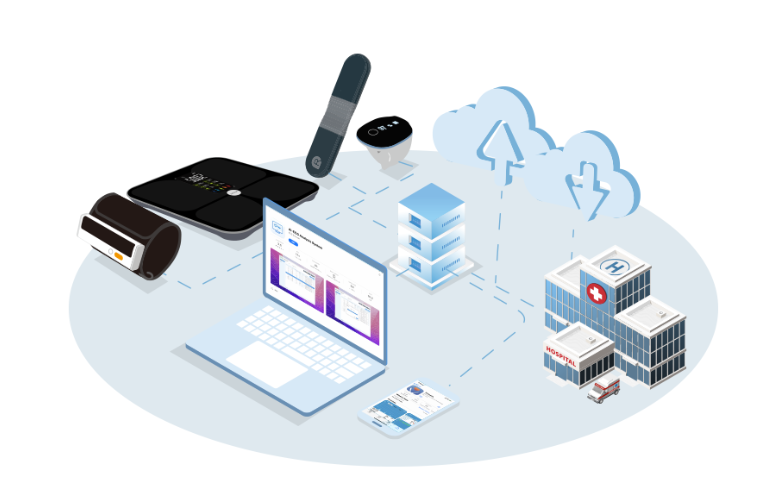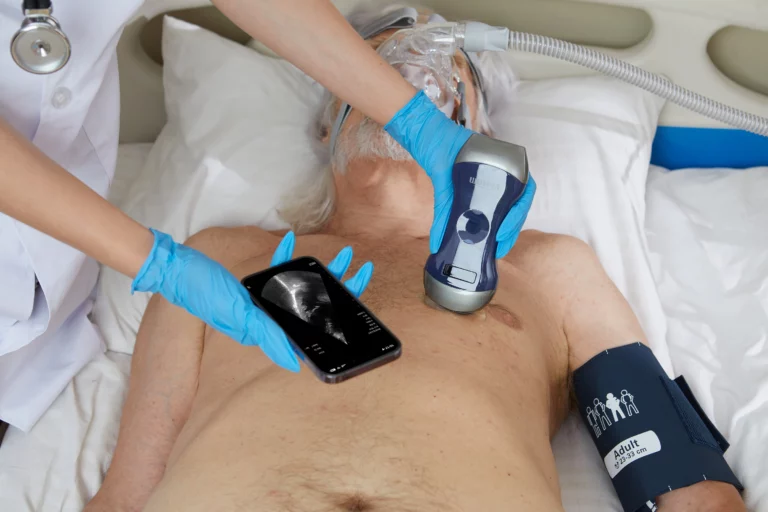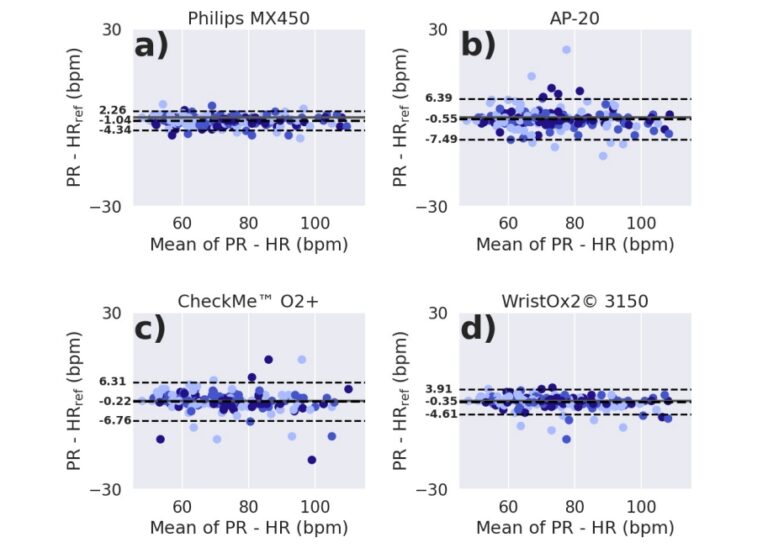The emergence of the loT System has made remote connections and data sharing remotely between systems and devices a reality. Virtual data access and management have given rise to digital health, remote patient monitoring, online nursing, etc., which are changing primary care. Among them, real-time remote patient monitoring is being widely used for treatment tracking, risk warning and medical resource coordination due to its friendliness and flexibility. Real-time remote monitoring refers to real-time vital sign data collected by wearable medical devices transmitted to a cloud-based healthcare platform to ensure that healthcare providers can promptly intervene and respond to any changes in health status.
Moreover, a report by GlobalData highlights the growth in the remote patient monitoring system market. Projected to reach $760 million by 2030, up from $548.90 million in 2020, this market will experience a compound annual growth rate of 3.3% over the decade. It is compelled by the incidence of chronic diseases, the aging people, and the demand for worthwhile healthcare solutions, which imitates a trend towards more efficient, technology-enabled healthcare delivery.

Applications & Global Coverage of RPM
Let’s first discuss the applications of RPM in different diseases and the factors in monitoring them.
- Cardiovascular Diseases
The key to the management of heart failure patients is timely adjusting medication regimens and preventing rehospitalization. Remote in-home monitoring, facilitated by wearable devices, is enhancing the efficacy of these pivotal measures, thereby reducing heart failure mortality rates and diminishing the frequency of hospitalizations among chronic heart failure patients. After capturing ECG waveforms and ppg signals, wearable devices help physicians assess real-time changes in PCWP by calculating hemodynamic parameters and analyzing the performance of heart failure patients with compensation or decompensation. Cardiosense, Inc., a leading non-invasive cardiac monitoring platform, was awarded The Breakthrough Device Designation by the FDA.
- Cancer
Remote cancer monitoring based on wearable devices is expanding the scope of high-quality cancer care services and continuously driving progress toward medical equality. Increasing research and experiments indicate that remote patient monitoring has reduced the impact of complications and improved survival rates from three aspects: nursing experience, physical health, and expenditure. Despite digital implementation barriers such as age and language differences that still need to be addressed, surveys show that currently, 41% of healthcare institutions are using RPM services in cancer treatment, and 28% are considering optimizing current workflows through RPM plans.
- Diabetes
For diabetes management, RPM systems monitor blood glucose levels and medication adherence. Continuous glucose monitoring (CGM) devices with RPM allow for real-time adjustments in insulin therapy. Besides, these systems can collect data on dietary intake and physical activity, which helps in personalized diabetes care and controls worries like diabetic retinopathy or nephropathy.
- Neurological Disorders
In neurological disorders, remote patient monitoring systems are beneficial for tracking symptoms and medication effects in conditions including epilepsy or Parkinson’s. For example, RPM can monitor seizure activity or assess motor function through wearable sensors. This information helps fine-tune medication dosages, appraise treatment efficacy, and recover patient aftermaths.
- Infectious Diseases
RPM systems influence infectious disease management while monitoring patients with chronic viral infections like HIV or hepatitis. They enable regular tracking of viral loads and immune function markers, including CD4 counts, from a distance. Additionally, RPM can support the monitoring of antibiotic therapy in bacterial infections for adherence and usefulness.
- Respiratory Disease
According to statistics, 25% of mechanically ventilated patients experience significant patient-ventilator asynchrony (PVA), leading to prolonged ventilation time, intense discomfort, and unclear effectiveness, which are the main reasons for low compliance with respiratory therapy. Remote Patient Monitoring (RPM) built on electronic medical records (EMR), remote data collection, and artificial intelligence reinforcement learning has become an effective way to address the above issues. Key waveform segments collected through remote networks are used to construct deep learning frameworks for AI, enabling automatic identification and timely warning of PVA, including trigger anomalies, inspiratory phase anomalies, switch anomalies, and expiratory phase anomalies.

Global Coverage of RPM
According to statistics from Mordor Intelligence, the global telemedicine market was valued at approximately $104.44 billion in 2021 and is projected to reach a market size of $272.76 billion by 2027, with a CAGR of 20.5% during the forecast period of 2022-2027. The World Health Organization states that the period from 2020 to 2030 may be the decade in which digital technology reshapes healthcare systems.

Here is a specific illustration of the global coverage of RPM:
- North America (the United States)
The United States is one of the most developed countries in the world in terms of telemedicine. Currently, medical assistance programs in all 50 states of the United States cover certain types of telemedicine services. Most state employee health plans cover telemedicine insurance, and an increasing number of states recognize home as an initial place for medical treatment, thus qualifying for telemedicine subsidies. Additionally, some states are still working on achieving Medicare coverage for remote monitoring of chronic disease management through legislation or seeking federal exemptions.
The American Telemedicine Association (ATA) envisions the U.S. telemedicine market in 2030, believing that by then, telemedicine will permeate the entire process of user treatment and diagnosis, becoming a cornerstone of the U.S. healthcare system. Policies, regulations, and fiscal actions are continuously overcoming current limitations to support telemedicine in providing equal medical opportunities to more people.
- North America (Canada)
Since 2020, the COVID-19 pandemic outbreaks and the demand for telemedicine services have surged in Canada. According to the Virtual Care Report released by the Canadian Medical Association (CMA) in 2022, approximately 48% of clinics had started offering at least one form of virtual care since February 2020, and this proportion rapidly soared to 83% by September of the same year. Canadians have shown a higher acceptance of telemedicine, as indicated by a satisfaction survey conducted by the CMA in May 2020. The results revealed that 91% of respondents expressed satisfaction or high satisfaction with the telemedicine services they received, with an additional 42% indicating a preference for virtual medical services over waiting for over 10 hours at a clinic. Currently, over six million Canadians still don’t have a family doctor, prompting an increasing number of healthcare institutions and patients to advocate for remote consultations and digitization to expand access to care for more individuals.
- Europe (Germany/UK/France/Spain/Italy/Russia/Poland/The Netherlands)
Europe shows an assorted adoption of remote patient monitoring systems. Germany and the UK are at the forefront due to their healthcare infrastructures and regulatory environments. For example, Germany’s Digital Healthcare Act (DVG) provides a legal framework for digital health applications, including RPM. In the UK, the National Health Service (NHS) incorporates RPM in patient care for chronic disease management. Nevertheless, Eastern European countries like Poland and Russia, as well as France, Spain, Italy, and the Netherlands, are also gradually catching up while modernizing their healthcare systems with RPM technologies.
- Asia Pacific (China/Japan/India/Australia/South Korea/Thailand/Indonesia)
The Asia Pacific region reveals a growing market for remote patient monitoring systems, owing to swelling healthcare expenses and tech advancements. Japan and South Korea are prominent in implementing RPM for aging populations, using wearable devices for continuous therapeutic monitoring. In China, the government’s push for healthcare reform has included the acceptance of RPM to manage chronic diseases. India, Australia, Thailand, and Indonesia are also perceiving an adoption of RPM in urban areas. It is facilitated by smartphone penetration and internet access. The market in India is rising due to digital literacy and government initiatives promoting e-health.
- Latin America (Brazil/Argentina/Colombia/Peru)
In Latin America, remote patient monitoring systems are increasing in Brazil, Argentina, Colombia, and Peru. These systems manage chronic conditions, including but not limited to diabetes and hypertension. For instance, Brazil has comprehended a rise in telemedicine platforms integrating remote therapeutic monitoring, exclusively after the COVID-19 pandemic. Challenges like uneven healthcare access and limited infrastructure in rural areas remain. Governments and healthcare providers are progressively diagnosing the potential of RPM to bridge these gaps.
- Middle East & Africa (South Africa/Saudi Arabia/UAE)
The Middle East and Africa are emergent markets for remote patient monitoring systems. Saudi Arabia and the UAE are top in assumption. The focus is on managing cardiovascular diseases and diabetes, given the prevalence in the region. For example, the UAE’s Ministry of Health and Prevention has been realizing RPM projects for better patient care. The region’s investment in smart city initiatives integrates RPM into broader digital healthcare infrastructures. South Africa is reconnoitering RPM to extend healthcare services to remote and underserved areas. However, challenges like infrastructure and technology implementation pace persist.
Top Suppliers of Remote Patient Monitoring Platforms
As countries and areas launch their plans in the RPM sector, RPM services and programs are springing up at a surprising speed. Among these RPM services suppliers, six of them stand out with their diverse specialized fields.

| SeamlessMD | |
| Geography Location | Toronto, Canada |
| Service range | Surgery, Oncology, Chronic Disease |
| Features | Patient Engagement |
| Personalized Education | |
| Patient Progress Tracking | |
| Remote Patient Monitoring | |
| Analytics & Reporting | |
| EHR Integration | |
| Additional Capabilities | |
SeamlessMD separates itself in the remote patient monitoring system market in North America. It offers a digital platform designed for patient engagement across various healthcare journeys, including surgery, oncology, chronic disease, and other medical care episodes. Its system integrates deeply with existing Electronic Health Records for better patient engagement through bespoke digital care plans. Patients are prompted to track their recovery by using tools such as pain or wound photos, which are then shared with healthcare providers. The product enables patients to fully realize and act on the importance of self-care education or timely communication with healthcare providers. Ultimately, patient outcomes and satisfaction are improved.
SeamlessMD has been accepted in the KLAS Emerging Solutions Top 20 Report for its worth across healthcare metrics. Their platform is patient-centric, with abridged readmission rates and enriched patient outcomes in post-operative care.
| HealthSnap | |
| Geography Location | Miami, USA |
| Specialized Solutions | Chronic Disease |
| Features | Simplified Data Collection |
| Integrated Health Insights | |
| Easy-to-use Interface | |
| Customizable Alerts | |
| Comprehensive Patient Profile | |
| Enhanced Communication Tools | |
HealthSnap’s remote patient monitoring system is acknowledged because it can manage numerous chronic conditions. Based in Miami, HealthSnap integrates RPM and CCM solutions. HealthSnap’s platform is designed to be simple, secure, and effective, aligning with the evolving value-based healthcare. They are committed to providing proactive patient care that improves outcomes, resulting in increased revenue for their partners. Their integrated virtual care platform delivers valuable medical advice and is promised to be HITRUST-certified and HIPAA-compliant for data security. Their recent $9 million Series-A funding expands care management services and reorients novel clinical use cases. HealthSnap’s system is illustrious since it can assimilate data from multiple devices while offering AI-guided care coordination and comprehensive patient analytics.
| Rimidi | |
| Geography Location | Atlanta, USA |
| Specialized Solutions | Diabetes, Heart Failure, Fatty Liver Disease, Cardiovascular Disease Obesity, Respiratory, Chronic Kidney Disease |
| Features | Integrates with Major EMRs |
| Diverse Disease Support Tailored for Various Disease States | |
| Patient-centric Approach | |
| Outsourced Monitoring Services | |
| Billing and Audit Support | |
Rimidi’s remote patient monitoring system is personalized for cardiometabolic management, focusing on diabetes. While integrating with Dexcom’s CGM system, the company manages diabetes more effectively. Their RPM system is designed to deliver quality improvement, workflow optimization and patient engagement within existing EHR workflows. By combining data from connected devices with clinical data in the EMR, they can provide more timely and in-depth patient-specific clinical insights. Their recent addition of the Glycemic Risk Index to their platform typifies that they incorporate unconventional clinical metrics. Rimidi’s system supports clinicians in making data-driven decisions for better patient outcomes in chronic disease management.
| Xealth | |
| Geography Location | Seattle, USA |
| Specialized Solutions | General |
| Features | Digital Health Formulary Strategy |
| Care Team Clinical Workflow | |
| Digital Front Door Activation | |
| Clinical AI Engine | |
| Monitoring, Notification & Data Management | |
| Integration Management | |
| Digital Care SMART on the FHIR App | |
| Digital Command Center | |
| Centralized Integration Suite | |
Xealth offers a remote patient monitoring system that centralizes digital health tools within a healthcare provider’s EHR. It simplifies digital care delivery and generates insights into patient engagement and outcomes. For example, during the peak of COVID-19 infections, many hospitals were challenged with their ability to admit patients. MemorialCare approached Xealth to collaborate on introducing the Twistle COVID remote monitoring program into their digital care workflows and streamlining the patient registration process. Recently, Xealth’s collaboration with Montage Health verifies that its system can boost patient care through updated access to digital health resources. This partnership signifies that Xealth integrates digital health strategies into existing clinical workflows.
| GetWell | |
| Geography Location | Maryland, USA |
| Specialized Solutions | General |
| Features | Activation & Growth |
| EHR-based automation and documentation | |
| 300+ Digital Care Plans | |
| SDOH Screening and Navigation Resources | |
| ED Interactive Experience | |
| Navigation to Providers and Services | |
GetWell, known for its consumer digital patient engagement products, has moved into health plans for better RPM. Their platform, Get Well 360, nurtures deeper patient relationships and develops clinical quality. Get Well 360 is designed to improve the healthcare experience for patients through digital technology, enhancing communication and outcomes. GetWell claims to have the largest portfolio of patient engagement solutions on the market, and its flexible approach to patient engagement allows partner organizations to customize their approach and frequency of communication for each individual patient, helping to expand the reach of the population, reduce unnecessary costs, and ultimately increase treatment satisfaction. Adding Christian Bagge as Head of the Payer Strategy highlights that they use digital tools for better health plan member engagement and outcomes. GetWell’s approach features the value of a high-tech, high-touch methodology in scaling member outreach.
| Perigen | |
| Geography Location | North Carolina, USA |
| Specialized Solutions | Maternal-Fetal Surveillance and Early Warning System |
| Features | Perinatal Analytics |
| Electronic Fetal Monitoring (EFM) | |
| Decision Support Tools | |
| Labor Analysis | |
| Documentation and Reporting | |
| Patient Safety and Quality Improvement | |
Perigen offers a remote patient monitoring system focused on maternal-fetal health with FDA-cleared AI-based early warning systems. Their PeriWatch® platform provides statistical analysis features for heightened clinical efficiency during childbirth. This PeriWatch Surveillance recording system specifically for fetal monitoring is a pioneer in its field in the US market. It provides near real-time analytical tools and scalable workflows to help labor and delivery teams increase productivity and safety, and make informed decisions through efficient information flow. The recent appointment of Dr. John Parker as Chief Medical Officer reflects that Perigen advances maternal and infant healthcare through expert leadership and technology. This move accentuates that the company integrates clinical expertise with technology to develop care outcomes in perinatal settings.
| Teladoc Health | |
| Geography Location | NewYork, USA |
| Specialized Solutions | Urgent Care, Primary Care, Mental Health, Diabetes, Diabetes Prevention, Hypertension, Weight Management, Specialty Wellness |
| Features | l Offer increased value |
| l Improve clinical outcomes | |
| l Boost engagement and satisfaction | |
| l Accommodate change | |
| l Seamless hybrid care from a single app | |
Teladoc Health, which has continued to expand globally through acquisitions since going public on the New York Stock Exchange in 2015 (ticker symbol TDOC), specializes in services such as primary care and telemedicine for complex diseases and currently has an updated market capitalization of about $23 billion. The company has five sub-brands: Teladoc, Advance Medical, Best Doctors, BetterHelp, and HealthiestYou.
Recently, Teladoc Health’s telehealth platform has broadened its partnership with Microsoft to incorporate the technology company’s AI solutions into its system. This integration enables healthcare providers to streamline the process of creating clinical documentation while conducting virtual examinations.
Wearable Medical Devices
Simply put, RPM is enduring growth, with its market reaching $760 million by 2030, pushed by chronic diseases and aging populations. Vitally, RPM’s applications extend across medical fields, including cardiovascular, cancer, diabetes, neurological, infectious, and respiratory diseases, for real-time remote monitoring and personalized care.
What is more, remote patient monitoring systems in healthcare bring new potential and challenges. Wearable medical devices have become the main stone to transmit and analyze real-time data. Patients could use wearable medical devices provided by physicians such as Viatom Checkme Pro to monitor ECG, sleep quality, blood pressure fluctuations and record more health data which will provide a more reliable basis for physicians or health centers to diagnose or make a therapy plan.


Viatom wearable medical devices have been integrated into many telehealth solutions, The changes brought about by wearable medical devices not only save hospital resources and patients’ medical costs but also have great significance in improving patient compliance. Patients can use the Vihealth app matched with Viatom products to obtain monitoring data of vital signs such as blood oxygen, blood pressure, and electrocardiogram. Medical-grade precision wearable medical devices have helped tens of thousands of patients with chronic diseases monitor their physical conditions anytime and anywhere, becoming an important communication channel between doctors and patients.
About us
Viatom focuses on the development of home health products and hospital monitoring products based on physiological parameters such as blood oxygen and blood pressure, using advanced technology to evolve them into products and services that meet the requirements of medical standards. In addition, Viatom has always been a leader in the smart healthcare industry and is committed to connecting users, service providers and healthcare industry players through high-quality products and big data algorithms, providing a strong technical foundation for “port + cloud data”. We insist to providing reliable healthcare solutions by efficiently applying and integrating healthcare resources.
Reference:
[1] Virtual Care and Telemedicine – Thematic Intelligence
https://www.globaldata.com/store/report/virtual-care-and-telemedicine-theme-analysis/
[2] Building The World’s Largest Healthcare Data Platform
[3] Remote Patient Monitoring Market / RPM Market by Product(Software, Services, Devices,
Cardiology, Neurological, BP Monitors, Neonatal, Weight, Temperature, Neuro), End user
(Providers, Hospitals, Clinics, Home care, Patients, Payers) & Region – Global Forecast to
2028
https://www.marketsandmarkets.com/Market-Reports/remote-patient-monitoring-market-77155492.html
[4] Remote patient monitoring in the medical device industry: analyzing innovation, investment and hiring trends
https://www.medicaldevice-network.com/data-insights/remote-patient-monitoring-in-medical/
[5] Europe Remote Patient Monitoring Market Research Report
https://www.marketdataforecast.com/market-reports/europe-remote-patient-monitoring-market
[6] Remote Patient Monitoring Market Research Report Information By Type
https://www.marketresearchfuture.com/reports/remote-patient-monitoring-market-10905
[7] South America Remote Patient Monitoring Systems Market Size & Share Analysis – Growth Trends & Forecasts (2024 – 2029)
[8] Middle East & Africa Remote Patient Monitoring Market Size & Share Analysis – Growth Trends & Forecasts (2024 – 2029)
[9] How Health Systems Are Using RPM to Extend Cancer Care into Patient Homes
[10] Patient ventilator asynchrony in critically ill adults – NCBI
https://www.ncbi.nlm.nih.gov/pmc/articles/PMC5939575/
[11] Telemedicine Market – Size, Share, Trends & Growth
https://www.mordorintelligence.com/industry-reports/global-telemedicine-market-industry
[12] VIRTUAL CARE IN CANADA: PROGRESS AND POTENTIAL
https://www.cma.ca/sites/default/files/2022-02/Virtual-Care-in-Canada-Progress-and-Potential-EN.pdf





